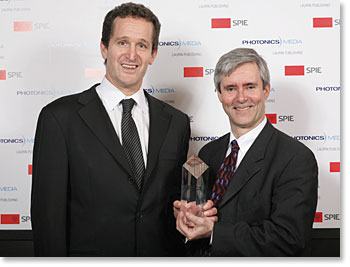NoblePeak Innovators “Glow” in the Dark
SPIE members Clifford King and Conor Rafferty, who founded NoblePeak Vision in 2002, received a Prism Award for Photonics Innovation in January for NoblePeak’s TriWave camera, a germanium-enhanced CMOS image sensor technology with sensitivity in the visible to SWIR region.
NoblePeak Vision, which produces silicon-based imaging products for military, security, and automotive applications, was among 10 firms from Spain, Germany, and the United States who won awards at SPIE Photonics West.
The global competition, which recognized innovative products, processes, and technologies for the photonics industry that were brought to market between September 2007 and September 2008, was open to SPIE members and non-members.

NoblePeak Vision’s groundbreaking TriWave imager, which won in the detectors, sensing, and imaging category, solves the problem of outdoor night vision by capturing the Earth’s natural SWIR “night glow.” Night vision is especially important to the defense and security industry where detecting and recognizing objects 24/7 is critical. Germanium is sensitive in the visible to SWIR spectra because of its low band gap voltage.
“The Prism award is very special,” said Phil Davies, vice president of marketing and sales. “It’s a huge validation … from an independent source about what the technology can do.”
NoblePeak Vision is the first company to grow thick, virtually defect-free germanium on silicon by solving the lattice mismatch problem and enabling a high-volume, low-cost, standard manufacturing process for surveillance cameras. Germanium achieves good quantum efficiency and its absorption curve is close to that of lattice-matched InGaAs, often used for SWIR imaging.
Dislocation trapping was used to grow thick, pure germanium with negligible defect density. The innovative growth technique integrates germanium islands with silicon transistors and metal layers using a standard, foundry-based CMOS process.
The germanium is then used as the photodiode structure in the CMOS image sensor in place of silicon photodiodes. The camera has a spectral response of 400nm to 1650nm. Large imaging arrays up to mega pixel resolutions are possible due to the 10 μm pixel size.
The Prism Award for Photonics Innovation is just the latest honor for the Massachusetts startup. In April 2008, the TriWave technology won “Best of Show” honors at the International Security Conference’s New Product Showcase, and the company was named the world’s best security startup in the Global Security Challenge in 2007.
King and Rafferty received their PhDs in electrical engineering from Stanford University and were colleagues at Bell Laboratories before founding NoblePeak.
King is NoblePeak’s COO and has 11 issued patents and 8 patents pending. His extensive experience in the semiconductor industry began with fabricating the world’s first silicon-germanium heterojunction bipolar transistor using chemical vapor deposition in 1988 while at Stanford. This device innovation later became the focus of extensive development efforts at many organizations including IBM, Siemens (Infineon), NEC, and AT&T (Lucent/Agere).
King, who has authored more than 60 publications, led the team that developed silicon germanium BiCMOS technology at Lucent Technologies, which later became Agere Systems. Working closely with marketing and manufacturing groups at Lucent/Agere, King and his team transferred research innovations into critical technology used throughout Agere’s product portfolio.
King noted that while many other researchers have worked with germanium as a detector, none had used CMOS technology. “That was the innovation,” he said.
Rafferty, NoblePeak’s CTO, is a leader in semiconductor process and device modeling. While at Stanford, he co-authored the simulation tools SUPREM4 and PISCES, which have served for 20 years as the industry standard toolset for silicon technology modeling (TCAD).
At Bell Labs, Rafferty managed research in silicon process development and electronic design automation. He was at the forefront in promoting process and transistor optimization through TCAD over five generations of CMOS technology, enabling new technologies such as halo transistors and retrograde tubs. He has 100 publications and nine patents to his credit.
NoblePeak Vision provides camera core and imager products that provide breakthrough night vision performance for the security, transportation, automotive, and defense markets. Founded in 2002 by SPIE members Conor Rafferty and Clifford King, NoblePeak Vision is a private company funded by Matrix Partners and North Bridge Venture Partners. The company is headquartered in Wakefield, MA, and received $12 million in series B financing in March 2008.
NoblePeak representatives will be at Booth 641 at SPIE Defense, Security, and Sensing in Orlando in April.




